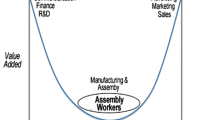Abstract
The US food retailing industry continues to concentrate and consolidate. Power in the agriculture, food, and nutrition system has shifted from producers to processors, and is now shifting to retailers. Currently, only eight food-retailing corporations control the majority of food sales in the United States. Expanding on previous research by Lyson and Raymer (2000, Agriculture and Human Values 17: 199–208), this paper examines the characteristics of the boards of directors of the leading food retailing corporations and the indirect interlocks that bind the food retailers into a corporate community.
Similar content being viewed by others
References
Barnes R. C., E. R. Ritter (2001). Networks of corporate interlocking: 1962–1995. Critical Sociology 27: 192–220
Bowlby R. (2001). Carried Away: The Invention of Modern Shopping. New York, New York: Columbia University Press
Burch D., G. Lawrence (2005). Supermarket own brands, supply chains and the transformation of the agri-food system. International Journal of Sociology of Agriculture and Food 13(1): 1–18
Clarke I. (2000). Retail power, competition and local consumer choice in the UK grocery sector. European Journal of Marketing 34(8): 975–1002
Dixon J. (2003). Authority, power and value in contemporary industrial food systems. International Journal of Sociology of Agriculture and Food 11(1): 31–40
Domhoff G. W. (2002). Who Rules America? Power and Politics. Boston, Massachusetts: McGraw Hill
Emirbayer M., J. Goodwin (1994). Network analysis, culture and the problem of agency. The American Journal of Sociology 99(6): 1411–1454
Factiva (2005). Kroger. Retrieved from http://www.global.factiva.com/en/arch/print_results.asp on November 1, 2005
Food Marketing Institute (2005). Facts & figures – key facts: Who shops. Retrieved from http://www.fmi.org/facts_figs/keyfacts/whenshop.html on January 1, 2006
Guptill A., J. Wilkins (2002). Buying into the food system: Trends in food retailing in the US and implications for local foods. Agriculture and Human Values 19: 39–51
Harvey, M., A. McMeekin, S. Randles, D. Southerton, B. Tether, and A. Warde (2001). “Between demand and consumption: A framework for research.” Manchester, England: Centre for Research on Innovation and Competition (CRIC), The University of Manchester, Discussion Paper No 40. Retrieved from http://www.cric.ac.uk/cric/Pdfs/dp40.pdf on November 1, 2006
Hendrickson, M. and W. Heffernan (2005). Concentration of Agricultural Markets. Retrieved from http://www.nfu.org/documents/legislative/Concentration_Tables_2004.pdf November 1, 2005
Hendrickson M., W. Heffernan, P. Howard, J. Heffernan (2001). Consolidation in food retailing and dairy. British Food Journal 103(10): 715–728
Hollingsworth A. (2004). Increasing retail concentration: Evidence from the UK food retail sector. British Food Journal 106(8): 629–638
Hughes A. (1996). Forging new cultures of food retailer-manufacturer relations? In N. Wrigley, M. Lowe (eds.), Retailing, Consumption and Capital: Towards the New Retail Geography (pp. 90–115). Essex, England: Longman Group Limited
Humphery K. (1998). Shelf Life: Supermarkets and the Changing Cultures of Consumption. Cambridge, United Kingdom: Cambridge University Press
Kaufman, P. (2000). “Consolidation in food retailing: Prospects for consumers and grocery suppliers.” Agriculture Outlook, United States Department of Agriculture, Economic Research Service, August 2000, 18–22
Lyson T., A. L. Raymer (2000). Stalking the wily multinational: Power and control in the U.S. food system. Agriculture and Human Values 17: 199–208
Mayo J. (1993). The American Grocery Store: The Business Evolution of an Architectural Space. Westport, Connecticut: Greenwood Press
Miller D., P. Jackson, N. Thrift, B. Holbrook, M. Rowlands (1998). Shopping Place and Identity. London, United Kingdom: Routledge
Mizruchi M. (1994). Social network analysis: Recent achievements and current controversies. Acta Sociologica 37: 329–343
Mizruchi M. (1996). What do interlocks do? An analysis, critique and assessment of research of interlocking directorates. Annual Review of Sociology 22: 271–298
O’Hagan S. B., M. B. Green (2004). Corporate knowledge transfer via interlocking directorates: A network analysis approach. Geoforum 35: 127–139
Reuters (2005). “Albertsons, pressed by rivals, puts itself up for acquisition.” The New York Times (New York), September 2, 2005, C7
Tarnowski, J. and W. Heller (2004). “The Super 50.” Progressive Grocer, May 1, 2004, 59–66
Urbanski A. (2000). The Super 50. Supermarket Business 55(4): 10–18
US Census Bureau (1992). Guide to the 1992 Economic Census. Retrieved from http://www.census.gov/econ/census92/guide on May 1, 2005
US Census Bureau (1997). Guide to the 1997 Economic Census. Retrieved from http://www.census.gov/econ/census97/guide during Spring, Summer, and Fall 2005
US Census Bureau (2002a). Guide to the 2002 Economic Census. Retrieved from http://www.census.gov/econ/census02/guide during Spring, Summer, and Fall 2005
US Census Bureau (2002b). 2002 Economic Census: Retail Trade Industry Series – Food and Beverage Stores. Retrieved from http://www.census.gov/prod/ec02/ec0244i07.pdf during Spring, Summer and Fall 2005
Wellman B. (1983). Network analysis: Some basic principles. In R. Collins (ed.), Sociological Theory – 1983 (pp. 155–200). San Francisco, California: Jossey-Bass
Winn-Dixie (2005). Winn-Dixie stores, inc. files for Chapter 11 reorganization to address financial and operational challenges. Retrieved from http://www.winndixie.com on October 1, 2005
Wrigley N. (2001). The consolidation wave in U.S. food retailing: A European perspective. Agribusiness 17(4): 489
Acknowledgments
We are especially grateful for Jeff Sobal’s support during the entire research, writing, and editing process. We would also like to thank the four anonymous reviewers for their insightful comments. An earlier version of this paper was presented at the annual joint meeting of the Agriculture and Human Values Society and the Association for the Study of Food and Society in 2005.
Author information
Authors and Affiliations
Corresponding author
Additional information
Rachel Schwartz is a PhD Candidate in the Department of Development Sociology at Cornell University. Her research interests are focused on the relationship between food retailers and food consumers in the United States, especially in regards to the construction of the concept of “choice.”
Thomas Lyson was Liberty Hyde Bailey Professor in the Department of Development Sociology at Cornell University. His interests included the relationship of agriculture and food systems on community economic development and population health. His most recent book, Civic Agriculture, developed a problem-solving model for food and agriculture issues. Dr. Lyson passed away in December 2006.
Rights and permissions
About this article
Cite this article
Schwartz, R., Lyson, T. Retail relations: an interlocking directorate analysis of food retailing corporations in the United States. Agric Hum Values 24, 489–498 (2007). https://doi.org/10.1007/s10460-007-9085-x
Accepted:
Published:
Issue Date:
DOI: https://doi.org/10.1007/s10460-007-9085-x




